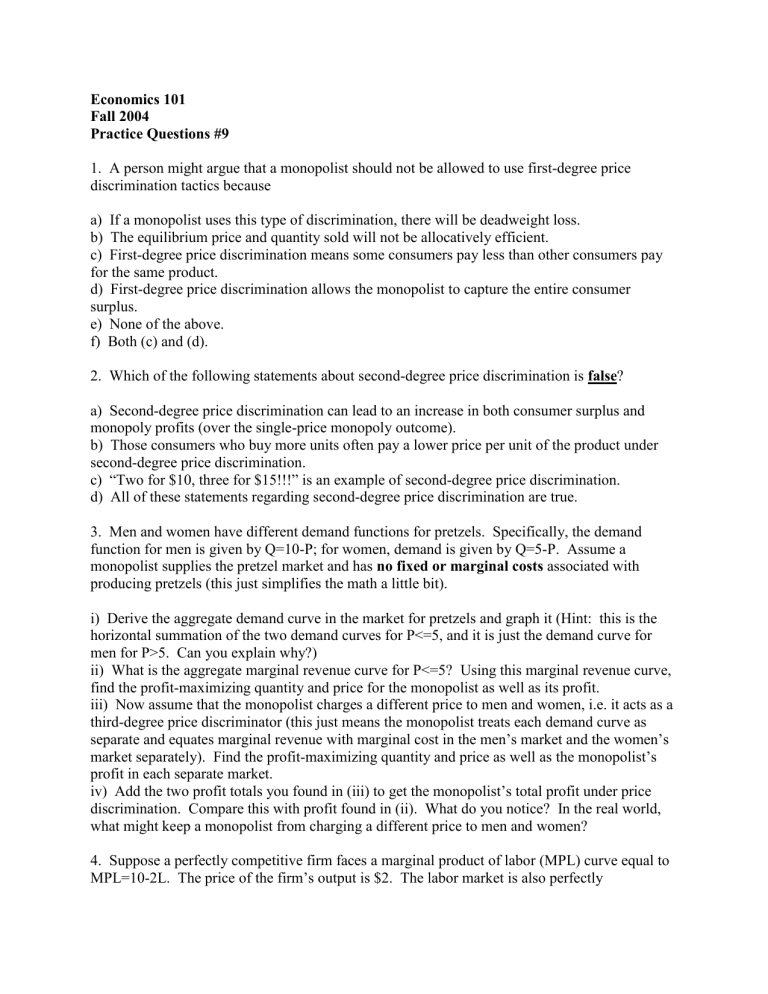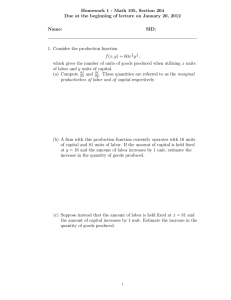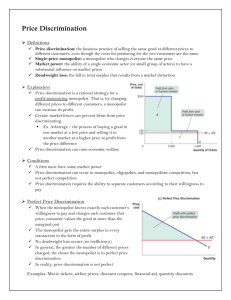Economics 101 Fall 2004 Practice Questions #9

Economics 101
Fall 2004
Practice Questions #9
1. A person might argue that a monopolist should not be allowed to use first-degree price discrimination tactics because a) If a monopolist uses this type of discrimination, there will be deadweight loss. b) The equilibrium price and quantity sold will not be allocatively efficient. c) First-degree price discrimination means some consumers pay less than other consumers pay for the same product. d) First-degree price discrimination allows the monopolist to capture the entire consumer surplus. e) None of the above. f) Both (c) and (d).
2. Which of the following statements about second-degree price discrimination is false ? a) Second-degree price discrimination can lead to an increase in both consumer surplus and monopoly profits (over the single-price monopoly outcome). b) Those consumers who buy more units often pay a lower price per unit of the product under second-degree price discrimination. c) “Two for $10, three for $15!!!” is an example of second-degree price discrimination. d) All of these statements regarding second-degree price discrimination are true.
3. Men and women have different demand functions for pretzels. Specifically, the demand function for men is given by Q=10-P; for women, demand is given by Q=5-P. Assume a monopolist supplies the pretzel market and has no fixed or marginal costs associated with producing pretzels (this just simplifies the math a little bit). i) Derive the aggregate demand curve in the market for pretzels and graph it (Hint: this is the horizontal summation of the two demand curves for P<=5, and it is just the demand curve for men for P>5. Can you explain why?) ii) What is the aggregate marginal revenue curve for P<=5? Using this marginal revenue curve, find the profit-maximizing quantity and price for the monopolist as well as its profit. iii) Now assume that the monopolist charges a different price to men and women, i.e. it acts as a third-degree price discriminator (this just means the monopolist treats each demand curve as separate and equates marginal revenue with marginal cost in the men’s market and the women’s market separately). Find the profit-maximizing quantity and price as well as the monopolist’s profit in each separate market. iv) Add the two profit totals you found in (iii) to get the monopolist’s total profit under price discrimination. Compare this with profit found in (ii). What do you notice? In the real world, what might keep a monopolist from charging a different price to men and women?
4. Suppose a perfectly competitive firm faces a marginal product of labor (MPL) curve equal to
MPL=10-2L. The price of the firm’s output is $2. The labor market is also perfectly
competitive, and is characterized by the following two equations: L=20-W (demand) and L=4W
(supply). How many units of labor will this firm choose to hire if the firm maximizes profits?
5. If the marginal product of labor falls uniformly as the quantity produced increases in some market, and both this market and the labor market are perfectly competitive, then we may say a) Only the last unit of labor hired will receive a wage equal to its marginal revenue product. b) Some units of labor will be paid a wage that is greater than their marginal revenue product. c) Some units of labor will be paid a wage that is less than their marginal revenue product. d) None of the above. e) Both (a) and (b). f) Both (a) and (c).
6. Suppose there are only two firms—call them A and B—in the pencil market. These firms face no fixed costs and have constant marginal cost equal to $4. Market demand for pencils is given by the equation Q=20-P. Firms set their prices simultaneously, and consumers always buy the cheapest pencils (assume that if the firms’ prices are the same, then each firm serves half of the market). i) If these firms were to collude and act like a single monopolist, what would the price in this market be? What would the firms’ profits be? ii) Now assume A charges $1 less than the “monopoly” price found in (i), while B continues to charge the “monopoly” price. What is A’s profit? What is B’s profit? Based on your calculations, does A have an incentive to “cheat” on the collusive arrangement and charge $1 less than its rival? iii) Now assume that both firms have the option of charging the “monopoly” price or charging
$1 less than this price. Set up a payoff (profit) matrix for the two firms, with each price representing a strategy for each firm. What is the equilibrium? iv) Given your answer in part (iii), what do expect to happen to the market price if firms can charge any price they like (Hint: even though there are only two firms in this market, we will get the same price we would get in a competitive equilibrium).
7. Imagine there are only two Christmas tree lots in town (call them 1 and 2). Each is thinking about advertising on television. If neither firm advertises, each makes a profit of 20,000. If 1 advertises and 2 doesn’t, 1 makes a profit of 25,000 and 2 makes a profit of 30,000 (1’s advertisement benefits 2). If 2 advertises and 1 doesn’t, 1 makes a profit of 26,000 and 2 makes a profit of 27,000 (2’s advertisement benefits 1). If both firms advertise, then 1 makes a profit of
25,000 and 2 makes a profit of 27,000. i) Set up the payoff matrix for this game. ii) Find the equilibria (Hint: there are 2 in this game).








